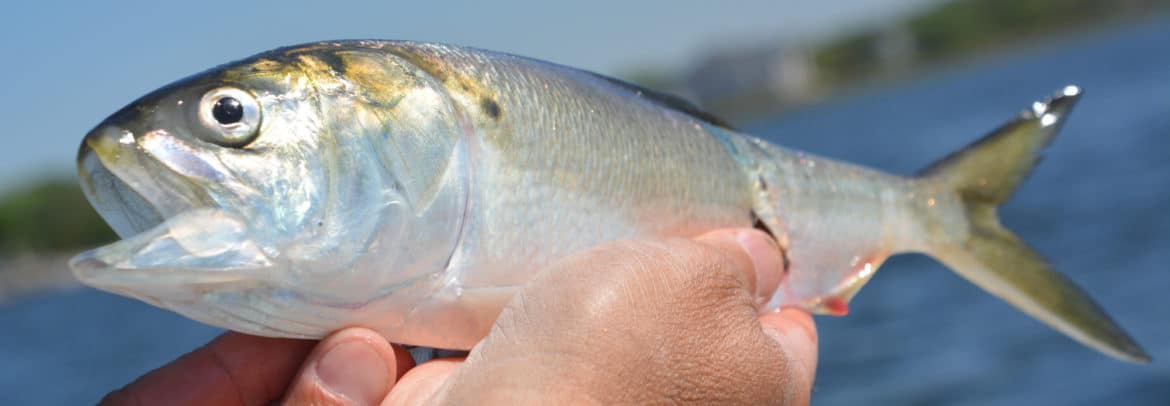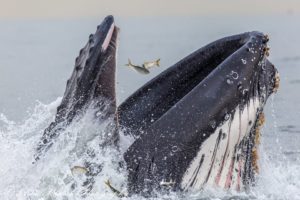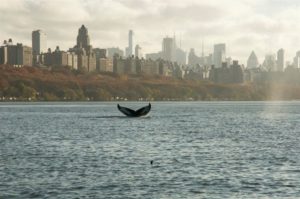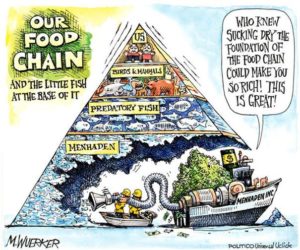- Welcome to Conscious Breath Adventures
What Do Humpback Whales Eat? Part 3: Menhaden
- Home
- Humpback Whales
- What Do Humpback Whales Eat? Part 3: Menhaden

Men…what?! Menhaden
by Cloe Waterfield
How can so many of us be completely oblivious to a fish described as the greatest fish in the sea? It is even the subject and title of an entire book.
We don’t even eat these fish – they are bony and so oily that they spoil quickly. Yet they are second only to Alaskan pollock in total tonnage of US landings. Most Americans have never even heard of them.
The Atlantic menhaden, Brevoortia tyrannusis, ranges from Nova Scotia to Florida. They reach up to 15” in length and can live for 10-12 years. They spawn in coastal areas and estuaries, like the Chesapeake Bay. Healthy ecosystems are critical for the survival of their young before they head out to sea as adults.

Menhaden can form vast schools, up to 200,000 fish. For whales, they are a critical food source particularly in the mid-Atlantic US and Gulf of Maine.
Here are 5 things you probably didn’t know, but should, about the marvelous menhaden:
- They have a bunch of weird names
The name menhaden itself is a bit of a mouthful (perhaps that’s why they are not more widely appreciated). Other common names include mossbunker, pogy, alewife, shad, bunker and fatback.
Maybe the oddest name, though, is bugfish. This unique moniker arises from a peculiar association with an isopod called Olencira praegustator, a crustacean which lives as a parasite inside their mouths.
The name menhaden is derived from their Native American name, munnawhatteaug, meaning ‘that which manures’, because….
- Thanksgiving may not have happened without them
A widely accepted historical anecdote goes that when the Pilgrims arrived in the New World, and struggled for survival during their first few months, a Patuxet man named Squanto gave them some tips and tricks. One was to bury a fish, believed to be a menhaden, with their corn (or maize) seeds, to act as a slow release fertilizer. And even today they are still used that way, because…
- They are reduced to a lot of ‘product’
The menhaden fishery is called a reduction fishery. It is as depressing as it sounds. We don’t eat the fish themselves but rather grind them up and parse the resulting slurry out into many other end uses.
There are probably many more but here’s a list of some of the main ones:
Fertilizer – they are still used to make soil amendments for crops such as onions and blueberries.
Pet food – that ocean flavor in cat or dog food is very likely menhaden.
Aquaculture – the fish farming industry uses huge quantities for feed.
Animal feed – not as obvious as fish farming but we also feed menhaden to feed farmed pigs, cattle and poultry.
Nutritional supplements – fish oil.
Other uses for menhaden product which you probably never knew about include in paint, soap, salad dressings, margarine, cosmetics and even to temper steel.
In addition to being ground into one of the variety of fates listed above, menhaden are also used as bait for crab and lobster fisheries. Those industries are often paralyzed if bait becomes unavailable.
- They have no teeth
A species description from 1964 noted “teeth wanting in adults”. Menhaden are filter feeders and an important link in the ocean food chain. They efficiently turn very tiny planktonic creatures into a meal-sized mouthful. Filtering up to 7 liters of seawater per minute, they have even been attributed with the ability to clean up the ocean.
- #NoBunkerNoHumpbacks
Menhaden, and other forage fish, are keystone species in marine food webs. They consume various planktonic plants and animals and are themselves eaten by top predators like birds, marine mammals and other fish. While the innocuous menhaden might lack charisma, it supports entire industries in marine recreation.

A clear example is the story of humpback whales in the waters around New York City. After a long absence, menhaden have returned the area and, hot on their heels, the humpback whales. Whale watchers can now enjoy two iconic sights in one frame: the Manhattan skyline and humpback whales.
In addition to whale watching, multi-million dollar sportfishing interests depend on healthy menhaden stocks to feed the striped bass, tuna, swordfish, cod and bluefish they catch. SCUBA divers also like to see big animals like sharks. Those sharks need forage fish.
However, conservationists are concerned that smart marine management is falling short. Catch quotas, set by coastal Atlantic states’ commissions, are not considering all that depends on the menhaden.

They are setting catch limits based just on a single species. Allowable catches of menhaden are creeping higher. Also, in a move that left many questioning the impartiality of the certification process, the Marine Stewardship Council recently certified the Gulf of Mexico menhaden fishery as sustainable. Groups such as Pew Environment and Menhaden Defenders decry the certification of any reduction fishery – ie a fishery that doesn’t really eat the target species, but grinds it up for fishmeal and other uses.
Campaigns and Chlorella
So what can we do to ensure a healthy future for the menhaden and all that rely on it? Being aware is one thing. It really doesn’t seem right that so much depends on such an unappreciated animal. Keeping up to date with management news, like quota changes, is another. You might also support campaigns targeting fishery regulators. It is encouraging that there are very engaged organizations like Menhaden Defenders that are trying to save the whales… by saving their food.
Personal choices make a difference too. We can choose protein sources other than lobster or farmed fish, which has a host of other issues, too. Or eat less chicken, pork and beef, which are also fed fishmeal. We can also skip the fish oil supplements and get our Omega 3’s from other sources like chlorella and flax. As a fish oil substitute, Chlorella and spirulina cut out the middle-man to a certain extent, by going straight to the source. As well as providing the building blocks for essential fatty acids, they are good detoxifiers and a source of iron and B vitamins.
Hopefully we can do these few things to help. If we do nothing else we can at least follow the tradition started by the Pilgrims and say thanks to these marvelous little fish.
Thanks for reading this latest post in our series “What Do Humpback Whales Eat?” Up next: herring!